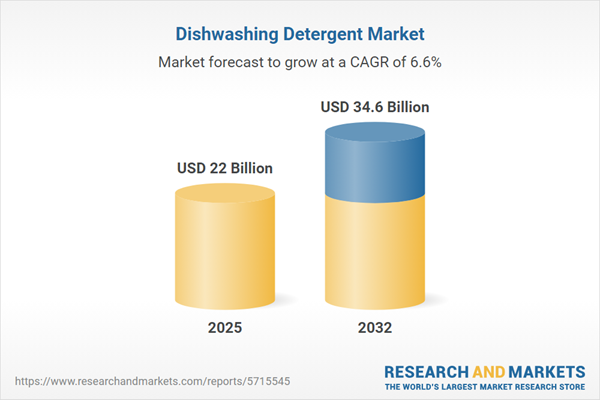Speak directly to the analyst to clarify any post sales queries you may have.
The dishwashing detergent market is experiencing rapid change as supply dynamics, regulations, and sustainability priorities reshape operational decision-making. Leaders must adapt strategies to remain competitive amid evolving procurement, formulation, and distribution landscapes.
Market Snapshot: Dishwashing Detergent Market Size and Growth
The dishwashing detergent market is projected to grow from USD 20.71 billion in 2024 to USD 22.00 billion in 2025, and is expected to reach USD 34.60 billion by 2032, registering a CAGR of 6.62%. Persistent growth reflects changes in consumer behavior, the impact of regulations, and a collective industry emphasis on sustainable solutions. Both household and commercial sectors are driving demand, while organizations are adapting to complex supply requirements and evolving buyer preferences. As the competitive landscape intensifies, a focus on compliance, innovation, and strategic investment is shaping leadership and value creation for senior decision-makers.
Scope & Segmentation: Strategic Insights for Senior Leaders
This report delivers comprehensive, actionable insights into every facet of the dishwashing detergent market, empowering organizations to anticipate market shifts and enhance resilience through focused strategy and smart investments. It highlights critical market segmentation and technological advances that inform both product development and targeted commercial positioning.
- Form: Includes liquid, powder, and tablet types, each suited to distinct cleaning applications and purchase preferences within households and professional environments.
- Packaging Type: Evaluates bottles, boxes, and refillable pouches, with emphasis on their influence over supply chain efficiency, cost reduction, and sustainability objectives.
- Fragrance: Covers a spectrum including citrus, floral, herbal, mint, and unscented options. This reflects diverse regulatory demands and shifting consumer preferences for safety and allergen disclosure.
- Formulation Type: Reviews traditional and eco-friendly detergents, assessing performance advancements alongside progress toward environmental responsibility.
- Distribution Channel: Considers sales through supermarkets, specialty retailers, direct digital outlets, and third-party e-commerce, highlighting the need for adaptable multi-channel strategies.
- End User: Encompasses commercial settings such as foodservice, hospitality, and healthcare, as well as household contexts, capturing broadening requirements for compliance and efficiency.
- Geographical Coverage: Spans North and South America, Western and Southern Europe, the Middle East, Africa, and Asia-Pacific, enabling strategic assessment of established markets and regions with emerging opportunity.
Key Takeaways for Strategic Decision-Making
- Packaging innovation is central to operational streamlining, supporting automation and minimizing waste, which is prioritized in B2B procurement.
- Ingredient transparency and responsible sourcing drive reformulation and influence supply chain decisions, aligning offerings with evolving marketplace and regulatory needs.
- Advances in surfactant and enzyme technologies are strengthening product performance and helping organizations to better manage costs and environmental impact.
- Omnichannel distribution increases agility, as organizations combine traditional and digital platforms to access diverse buying groups and quickly respond to market trends.
- Regulatory developments in chemical sourcing and formulation practices are pushing suppliers and manufacturers to enhance risk management and operational adaptability to ensure compliance.
Tariff Impact: Navigating Cost Pressures and Supply Chain Realignment
- Recently implemented U.S. tariffs are increasing supply chain costs, requiring renewed focus on margin protection within the dishwashing detergent sector.
- Expanding local production, diversifying supplier relationships, and launching biosurfactant and enzyme-forward solutions are key strategies to control costs and limit disruption.
- Stronger supplier partnerships and revised contracting are vital for resilience amid trade policy shifts and the ongoing volatility of international logistics.
Methodology & Data Sources
This market research integrates primary findings from executive interviews and targeted industry surveys with secondary research, including regulatory data and patent analysis. Scenario modeling and benchmarking enhance the relevance of insights for B2B leaders.
Why This Report Matters: Actionable Value for B2B Leaders
- Enables executive teams to benchmark strategy and prepare for regulatory and operational risk, supporting proactive market positioning.
- Provides detailed coverage of regulatory, formulation, and channel developments, equipping organizations with intelligence for agile response and investment planning.
- Delivers practical insights for procurement, supply chain, and sustainability leaders seeking to anticipate compliance requirements and strengthen business resilience.
Conclusion
Sustaining a competitive edge in the dishwashing detergent market requires ongoing attention to innovation, evolving regulations, and regional market shifts. Proactive, data-driven leadership is essential for long-term organizational growth and resilience.
Additional Product Information:
- Purchase of this report includes 1 year online access with quarterly updates.
- This report can be updated on request. Please contact our Customer Experience team using the Ask a Question widget on our website.
Table of Contents
3. Executive Summary
4. Market Overview
7. Cumulative Impact of Artificial Intelligence 2025
List of Figures
Samples

LOADING...
Companies Mentioned
The key companies profiled in this Dishwashing Detergent market report include:- Aaykay Detergents & Chemicals
- Amway Corporation
- Church & Dwight Co., Inc.
- Colgate-Palmolive Company
- Dalli Group
- Ecolab, Inc.
- Ecover
- Godrej Consumer Products Limited
- Henkel AG & Co. KGaA
- IFB Industries
- Kao Corporation
- Lemi Shine
- McBride PLC
- Morning Fresh
- Nice Group Co., Ltd.
- Novochem Resources Private Limited
- Persan S.A.
- Procter & Gamble Co.
- Reckitt Benckiser Group PLC
- S. C. Johnson & Son, Inc.
- Seventh Generation, Inc.
- Shanghai White Cat Group
- The Clorox Company
- Unilever PLC
- Werner & Mertz GmbH
Table Information
| Report Attribute | Details |
|---|---|
| No. of Pages | 193 |
| Published | October 2025 |
| Forecast Period | 2025 - 2032 |
| Estimated Market Value ( USD | $ 22 Billion |
| Forecasted Market Value ( USD | $ 34.6 Billion |
| Compound Annual Growth Rate | 6.6% |
| Regions Covered | Global |
| No. of Companies Mentioned | 26 |









